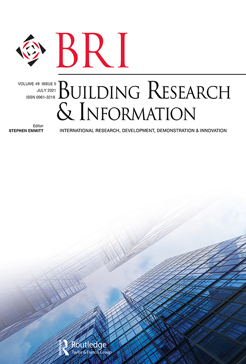
Diagnosing the Local Suitability of High-rise Timber Construction
Authors: Walker, T., Goubran, S.
© Building Research & Information, 2019
High-rise timber construction has attracted increasing attention among academics and practitioners in recent years. Publications place a heavy emphasis on the ecological and economic benefits of timber construction, but they pay less attention to the applicability of the technique to the local context. This paper proposes ten parameters that are used to develop a diagnostic tool to assess the suitability of a given location for the construction of high-rise timber buildings. The parameters cover economic, social, environmental, technical, and policy issues. Through visual representation of the outputs, the tool can be used to compare the merits of timber construction in different locations. Three locations are used to demonstrate the applicability of the diagnostic tool: the province of British Columbia (Canada), the state of São Paulo (Brazil), and the province of Quebec (Canada). An analysis of these locations reveals the capacity of the tool to identify the barriers, risks, and development opportunities for each location. Integrated design teams, developers, policymakers, and institutions could use this tool when selecting or proposing the structural material for building projects. Future development of the tool should aim to incorporate quantitative measures.
View this book on Taylor & Francis Online
A Psychological Approach to Regaining Consumer Trust after Greenwashing: The Case of Chinese Green Consumers
Authors: Walker, T., Barabanov, S., Wang, D.
© Journal of Consumer Marketing, 2020
The purpose of this study is to suggest an approach to regain consumer trust after negative effects of greenwashing that draws corporations and consumers into a conflicted relationship. The authors collect and interpret qualitative data from in-depth interviews to develop a theoretical approach that enables the rebuilding of trust between greenwashing corporations and their consumers using the concept of psychological resilience. This analysis indicates that the approach is an interaction between consumers with green brand loyalty and greenwashing corporations. This type of consumer demands emotional factors, functional factors and legitimate factors in the process of psychological resilience, and after greenwashing, corporations should select appropriate recovery strategies to stimulate these protective factors.
View this book on Emerald Insight
The Relationship between Financial Performance and Safety in the Aviation Industry: A Worldwide Perspective
Authors: Fardnia P., Kaspereit, T., Walker, T., Xu, S.
© International Journal of Managerial Finance, 2020
This paper investigates whether financial factors, which are presumed to influence an airline’s maintenance, purchasing, and training policies, are associated with the air carrier’s safety performance. We document an inverse relationship between the profitability of air carriers and their accident propensity. Other financial variables such as liquidity, asset utilization, and financial leverage also appear to affect an airline’s safety record, although these findings do not reach significance in all models. Flight equipment maintenance and overhaul expenditures are negatively related to accident rates. In addition, our results show that country-level variables related to the legal and economic environment have a significant effect on airline safety. Specifically, airlines in countries with strong law enforcement, more stringent regulatory systems, and better economic performance have superior safety performance. A series of robustness tests confirms our results.
View this book on Emerald Insight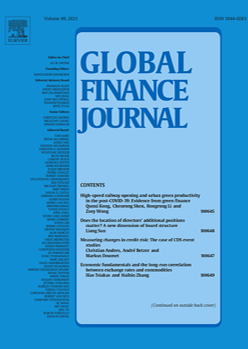
The Effect of Securities Class Action Lawsuits on Mergers and Acquisitions
Authors: Basnet, A., Davis, F., Walker, T., Zhao, K.
© Global Finance Journal, 2020
This paper investigates whether shareholder class action litigation affects the takeover candidacy, premium, and completion rate of mergers and acquisitions involving defendant target firms. We use a comprehensive dataset of publicly traded U.S. firms that became the targets of takeover bids between 1998 and 2016 and find that firms subject to shareholder class action lawsuits within the previous two years are more likely to be targeted for acquisition while commanding a significantly higher premium. Firms that face such litigation after a takeover announcement experience a significant decrease in takeover completion.
View this book on ScienceDirect
Basel Compliance and Financial Stability: Evidence from Islamic Banks
Authors: Bitar, M., Walker, T., Naceur, S.B., Ayadi, R.
© Journal of Financial Services Research, 2020
We find that compliance with the Basel Core Principles (BCPs) has a strong positive effect on the stability of conventional banks, and a positive but less pronounced effect on the stability of Islamic banks. We also find that the main impact of compliance is an increase in capital ratios, whereas other components of the Z-score are negatively affected. This reflects the desire of banks to be more closely integrated into the global financial system by holding higher capital ratios. The findings also justify the 2015 decision of the Islamic Financial Services Board to publish similar principles for Islamic banks.
View this book on SpringerLink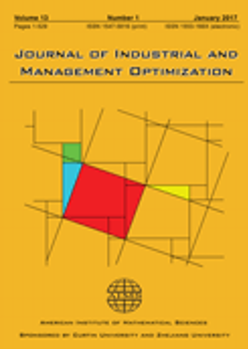
Decision-Making in a Retailer-Led Closed-Loop Supply Chain Involving a Third-Party Logistics Provider
Authors: Chen, X., Xu, P., Walker, T., Yang, G., Li, J.
© Journal of Industrial and Management Optimization, 2020
This paper investigates decisions in a three-echelon closed-loop supply chain composed of one manufacturer, one retailer, and one third-party logistics provider (3PL), with the retailer being dominant. Inspired by game theory, we develop an equilibrium model for a retailer-led, closed-loop supply chain under logistics outsourcing. We derive the optimal forward and reverse logistics decisions of each supply chain member. This article analyzes the effects of market size, consumers’ sensitivity to sales prices, the proportion of logistics costs, consumers’ environmental awareness, and consumers’ sensitivity to recycling prices on decision-making processes. Finally, we provide a numerical example to verify the validity of our conclusions. Our results indicate that the higher the manufacturer’s share in the forward logistics cost, the higher the sales price, the wholesale price, and the forward logistics service price, and the lower the order quantity. The higher the manufacturer’s share in the reverse logistics costs, the lower the recycling price, the transfer price, and the recycling amount, and the higher the reverse logistics service price. Whether it is forward logistics or not, the higher the manufacturer’s share in the logistics costs, the lower the profits of each member.
View this book on American Institute of Mathematical Sciences (AIMS)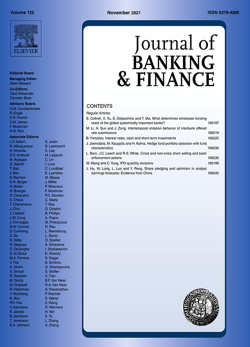
False Hopes and Blind Beliefs: How Political Connections Affect China’s Corporate Bond Market
Authors: Schweizer, D., Walker, T., Zhang, A.
© Journal of Banking and Finance, 2020
This paper explores whether and how political connections affect the market for corporate bonds issued by privately owned enterprises (POEs) in China. We test two competing theories – the zero-default myth and the borrower channel theory – that predict how political connections affect the likelihood of bond issuance, refinancing costs, the market reaction to a bond issue announcement, and firms’ post-issue performance. Using a sample of Chinese POEs from 2007 to 2016, we show that – in line with the zero-default myth theory – politically connected POEs are more likely to issue corporate bonds as a debt financing instrument than their non-connected counterparts. They also achieve lower coupon rates (i.e., lower refinancing costs), despite exhibiting lower overall performance after bond issuance. We find that investors react positively to corporate bond-issuing announcements if the issuing firm is politically connected. At the same time, our research indicates that politically connected bond-issuing POEs in China have weaker corporate governance and a surprisingly higher default probability than non-connected issuers.
View this book on ScienceDirect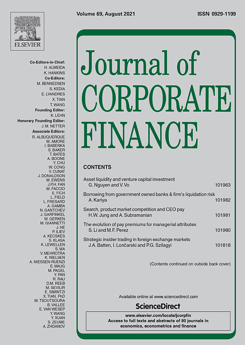
Institutional Trading in Firms Rumored to be Takeover Targets
Authors: Davis, F., Khadivar, H., Walker, T.
© European Financial Management, 2020
In this paper, we examine institutional trading in proximity to takeover rumors by combining the ANcerno dataset of transaction-level institutional trades with a unique sample of takeover rumor ‘scoops’. We find that institutions are net buyers in firms which subsequently become subject to takeover speculation and that institutional trading predicts which rumored firms will eventually receive takeover bids. Segregating funds according to their propensity to trade, we show that those less likely to purchase rumored targets by chance over the pre-rumor period are more likely to identify firms which will receive bid proposals and that they trade more profitably over both the pre- and post-rumor periods. We test for the presence of informed trading in a variety of ways and conclude that institutional investors appear to trade on material private information which identifies the firms soon to be the target of takeover speculation.
View this book on ScienceDirect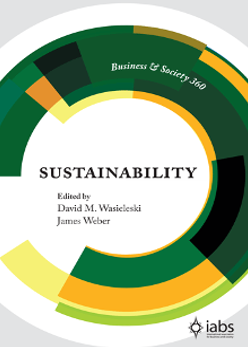
The Case For a Plastic Tax: A Review of Its Benefits and Disadvantages Within a Circular Economy
Authors: Walker, T., Gramlich, D., Dumont-Bergeron, A.
© Business and Society 360, 2020
In 2017, global plastic production reached 348 million tonnes. Despite growing concerns about the environmental challenges associated with both plastic production and plastic waste, recent estimates suggest that plastic production and subsequent waste is expected to double by the year 2035. To help reduce the amount of plastic waste that litters the oceans and damages the environment, the European Union (EU) has recently commissioned a study about the feasibility of levying a tax on plastic products. However, very few academic articles currently exist that critically examine the arguments for or against a plastic tax and thereby enlighten government and regulators on the subject. This paper investigates whether plastic taxes can be used as an economic disincentive for plastic products and explores its advantages and disadvantages within a circular economy. It explores whether a plastic tax is the right economic instrument to limit the use of plastics, generate design and technical innovations for bio-based materials and degradable/recyclable plastics, create other economic incentives to optimize the value of plastic and its waste collection, and increase public awareness and responsibility. We find that a plastic tax may be a suitable solution as it is likely to influence the design, production, consumption, and waste sectors if designed properly. Yet, the tax should be carefully implemented and combined with other instruments to obtain the desired outcomes and reduce the occurrence of unfavourable side effects.
View this book on Emerald Insight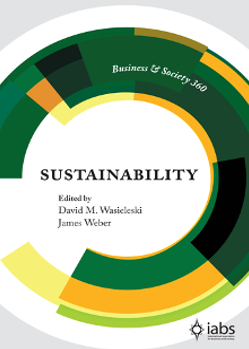
Sustainable Real Estate: Transitioning Beyond Cost Savings
Authors: Walker, T., Goubran, S.
© Business and Society 360, 2020
In recent years, sustainability considerations in the real estate sector have moved from being a niche market phenomenon to a mainstream trend. The movement has been accompanied by a shift in the industry’s perception of sustainable buildings. Traditional cost-saving goals are now complemented by a growing interest in the potential for sustainable buildings to tackle broader economic and social sustainability challenges as well as issues related to health and well-being. The real estate industry is increasingly expected to adapt its strategies to incorporate new and more stringent environmental and urban development requirements, to cater to shifting demographics, and to utilize new advancements in construction processes and materials. This chapter explores recent research on sustainable real estate and highlights some of the newest trends in the market. The chapter then examines how policy and technological advancements can enable real estate developers to tackle environmental, social, and economic sustainability challenges. This will be exemplified through a focus on carbon taxation and timber construction. Based on these case studies, the chapter illustrates how today’s sustainable real estate sector – marked by its move beyond a focus on cost savings – requires for building practices to be strongly rooted in global, sustainable development policies.
View this book on Emerald Insight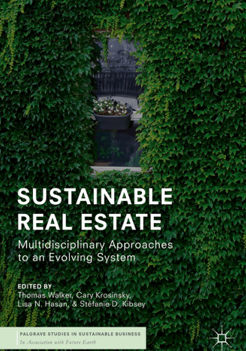
Evolutions in Sustainability and Sustainable Real Estate
Authors: Goubran, S., Masson, T., Caycedo, M.
© Sustainable Real Estate, 2019
This chapter presents historical, theoretical and practical background information for the area of sustainable real estate. The chapter takes a multidisciplinary approach and is structured around the three pillars of sustainability (social, economic and environmental) with a future outlook. It reviews the rise of the concept of sustainable development, explores the connections between the sustainable development goals and real estate, presents the relations and tensions between real estate and the three pillars of sustainability, discusses current trends and identifies possible future developments. The chapter concludes by presenting a map of the sustainable real estate system.
View this book on SpringerLink
Finance and Management for the Anthropocene
Authors: Shrivastava, P., Zsolnai, L., Wasieleski, D., Stafford-Smith, M., Walker, T., Weber, O., Krosinsky, C., Oram, D.
© Organization and Environment, 2019
The Anthropocene era is characterized by a pronounced negative impact of human and social activities on natural ecosystems. To the extent finance, economics and management underlie human social activities, we need to reassess these fields and their role in achieving global sustainability. This article briefly presents the scientific evidence on accelerating impacts of human activities on nature, which have resulted in breach of planetary boundaries and onset of global climate change. It offers some potential leverage points for change toward sustainability stewardship by highlighting the important role of finance and economics in addressing climate change. We examine the role of financial stakeholders in addressing planetary boundaries and offer a modified stakeholder theory, from which we propose future directions for finance in the Anthropocence era.
View this book on Sage Journals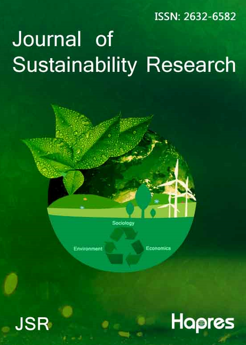
On the Role of Construction in Achieving the SDGs
Editor: Goubran, S.
© Journal of Sustainability Research, 2019
Construction and real estate have been central to the debates on sustainable development. However, the dominant definition of sustainability in construction and real estate remain centred on the environmental dimension. The 2030 Agenda and its Sustainable Development Goals (SDGs) offer new opportunities for the building sector to expand its focus. The available literature utilizes the existing green ratings, sustainability assessment tools and standards as the basis for investigating how construction and buildings can contribute to the 2030 Agenda for Sustainable Development. However, less focus was placed on exploring the broad intersection between the building sector, on the one hand, and the SDGs and their targets on the other. This paper uses a multi-step methodology to analyze the potential role of construction and real estate in the 2030 Agenda. The paper identifies SDG targets that depend (directly or indirectly) on construction and real estate activities, and reveals that 17% of the SDG targets are directly dependent and 27% of the targets are indirectly dependent on these sectors’ activities. The identified targets are analyzed and are found to be related to all 17 goals—with the largest contributions to SDGs 11, 6, and 7. The results of the analysis are mapped and illustrated in order to provide insights to academics, practitioners and governments. This research contributes to the literature on the implementation of the 2030 Agenda. It also exposes the synergistic possibilities, and the partnerships required, to make use of the potential role of construction and real estate in the implementation of the UN Agenda.
View this book on Hapres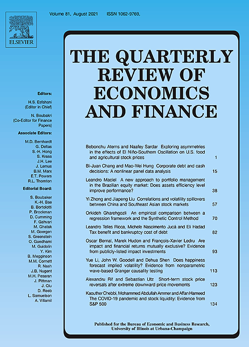
Competition, Securitization, and Efficiency in US Banks
Authors: Bayeh, A., Burlacu, R., Bitar, M., Walker, T.
© The Quarterly Review of Economics and Finance, 2021
Using a sample of 88,219 bank-year observations pertaining to 9,387 commercial US banks between 2001 and 2013, this paper investigates the bank-specific factors that increase the likelihood of securitization, the previously untested impact of securitization on efficiency, and the effect of the interaction between competition and securitization on efficiency. The main analysis shows that banks securitizing their loans are more efficient than other banks. We thus propose cost efficiency as a new mechanism that explains how securitization reduces bank screening and monitoring incentives. Surprisingly, deeper investigations show that the positive effect of securitization on efficiency is more pronounced in competitive banking markets. Overall, this paper offers important policy recommendations for bank regulators.
View this book on ScienceDirect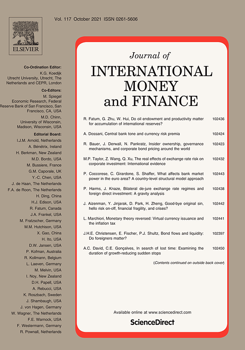
Fact or Fiction: Implicit Government Guarantees in China’s Corporate Bond Market
Authors: Walker, T., Zhang, X., Wang, Y., Zhang, A.
© Journal of International Money and Finance, 2021
This paper explores how implicit government guarantees affect the yield spreads of Chinese corporate bonds. We argue that quasi-municipal corporate bonds (“Chengtou” bonds), issued by local government financing vehicles (LGFVs), carry an implicit government guarantee and therefore enjoy a reduced yield spread. Using a sample of publicly traded corporate bonds between 2010 and 2017, we show that bond investors are significantly less sensitive to bond-specific risks for corporate bonds with an implicit government guarantee: the yield spreads of Chengtou bonds are significantly lower than those of corporate bonds issued by either privately-owned enterprises (POEs) or local state-owned enterprises (SOEs). Furthermore, we find that policy changes introduced by China’s central government, which were intended to regulate local governments’ debt financing activities, significantly reduced the gap in yield spreads between Chengtou bonds and bonds issued by either POEs or local SOEs. Overall, our results suggest that implicit government guarantees were a significant factor in China’s nascent corporate bond market, but that the country’s recent policy changes have reduced the effectiveness of such guarantees, making China’s corporate bond market more market-oriented.
View this book on ScienceDirect
Firm-and Country-Level Determinants of Green Investments: An Empirical Analysis
Authors: Barabanov, S., Basnet, A., Walker, T., Wendt, S., Yuan, W.
© Managerial Finance, 2021
We explain the determinants of corporate green investments (GI) by using a series of both firm- and country-level factors. We employ environmental expenditures as a proxy for green investments at the firm level. We find that larger firms tend to invest more in green projects, whereas firms that are more profitable are less likely to go green. In terms of country-level determinants, we find that GDP per capita and surface area are negatively related with GI, while population is positively associated with GI. Firms in English common-law countries and English-speaking countries invest less in GI than firms in other countries. To verify the results of our country-level determinants, we also perform a country-level test that employs a country’s ecological footprint as a proxy for GI. The results of the latter analysis are mostly in line with the results of our firm-level analysis. However, several of our findings are in contrast to previous research on the determinants of GI, suggesting that research in this area may be strongly influenced by researchers’ sample and variable choices.
View this book on Emerald Insight